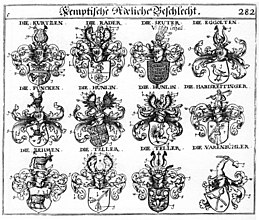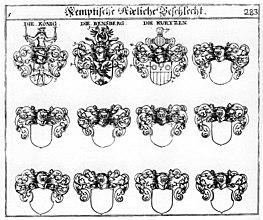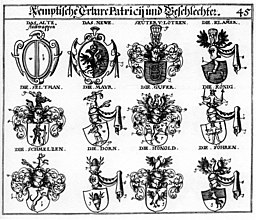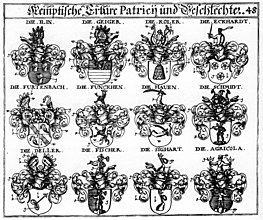Patriciate (Kempten)
The patriciate of the imperial city of Kempten , the patrician families grouped together in the "Burgerstube" , represented the center of power in the imperial city of Kempten until the Bavarian occupation in 1802 , alongside the guilds .
history
A privilege of King Rudolf von Habsburg in 1289 was the first step of the city from the sovereignty of the Kempten prince abbot. The privileges of the 14th century cemented Kempen's status as an imperial city, which, due to its location in the middle of the territory of the prince monastery of Kempten, led to constant disputes between the citizens and the prince abbot. In 1363 Kempten citizens used the abbot's annual invitation to Martin's dinner to conquer the city castle on the Burghalde . The imperial city was subsequently condemned to rebuild the destroyed castle. Prince Abbot Heinrich von Mittelberg (1356–1382), however, waived the fulfillment of the judgment and sold the castle, the hill and the associated quarries to the imperial city “for the sake of peace”.
In the inner city, the first half of the 14th century was marked by unrest in connection with disputes between the handicraft guilds and the upper class of the urban patriciate, which arose largely from former imperial and princely bailiffs and who ruled the city. The craftsmen demanded a share in power and in this connection formed themselves into eight guilds, the Kramer, baker, butcher, tailor, blacksmith, shoemaker, tanner and weaver. 1362 a mayor in the Presidency of the Council was first mentioned and in the wake of the ordered by the abbot Stadtammann limited to the management of the twelve-member City Court. In 1379 the guild constitution was established in an agreement with the prince monastery . The most important body was the “Little Council”, which initially had twelve members but in the late 15th century had 24 members. In some cases it was reinforced by the guild masters or the “Elfer” committees (the “community”) of the guilds (“Great Council”). In return, the patriciate joined forces in 1419 in the guild-like organization of the "Müßiggengel", the later "Burgerstube". In addition to this, there was another association of the imperial city upper class, the “Society for Ostriches”, which primarily served social purposes. The seat of the two companies was the Müßiggengelzunfthaus .
1488 was the city of Emperor Friedrich III. granted the right to self-administer through offices. The independence was strengthened by the coin minting permit from 1510 and the introduction of a court coat of arms with a court seal. Due to the negotiating skills of the mayor Gordian Seuter , who came from a patrician family, the town bought itself off from Prince Abbot Sebastian von Breitenstein during the Peasants' War in 1525 , when the imperial city acquired all rights of the prince's monastery within its city walls. At the Reichstag in Speyer in 1529 , the imperial city of Kempten was one of the signatories of the so-called protestation and thus got into further conflicts with the prince abbot. In 1548, with the Augsburg Interim , Emperor Charles V ordered the abolition of the old guild constitutions in the imperial cities, which the imperial commissioner Heinrich Has replaced in Kempten with a new, patrician-dominated city constitution based on the model of Nuremberg . After another revision of the city constitution, which took place in 1559, two mayors were at the helm, who took turns running the business every year. The representation of the citizenry was organized in three bodies: the five-member "Secret Council", which ran the day-to-day business, the 17 other members, the "Small Council" and the "Community", which was only called in on a case-by-case basis.
In the Thirty Years' War the Catholic prince and the Protestant imperial city belonged to the two hostile denominational parties and supported their respective allies in fighting their neighbors. The monastery was destroyed by the Swedes in 1632 at the instigation of the imperial city. In addition, there were two plague trains , so that the population of the imperial city collapsed from 6,000 before the war to 900 in 1635. The imperial city could not permanently prevent the rise of the princely settlement in Kempten. On April 19, 1728 this settlement around the residence and the collegiate church of St. Lorenz was given a diploma from Emperor Karl VI. raised to an independent city. For the collegiate city this meant city rights , but civil self-government was dispensed with.
Due to the Reichsdeputationshauptschluss of 1803, the imperial city and the prince monastery, both of which had already been occupied by Bavarian troops in 1802, lost their imperial freedom and fell to the Electorate of Bavaria . In 1804 the city got an administrative council, which replaced the previous magistrate . In 1818 the former imperial and collegiate city were united, the citizens could again elect a magistrate according to the Bavarian constitution of 1818 .
Familys
The patricians of the imperial city of Kempten included u. a. the families:
- Dorn : Hans Ulrich Dorn was mayor of the imperial city during the Thirty Years' War, he was the builder of the Dorn Castle
- Jenisch (also Ienisch): dressed several generations in the period 1631-1789 the mayor's office, in the 18th to 20th centuries in Hamburg active
- Kesel : Johann Adam Kesel was mayor of the imperial city from 1764 to 1773
- König (also Kunig): patrician family, later entered in the nobility register of the Kingdom of Bavaria, Georg Matthias von König was the first mayor after the unification of the imperial city and the collegiate city from 1818 to 1824.
- Neubronner : Ulm patrician family with a branch from Kempten, the family built the Rotschlößle
- Schmelz: Johannes Schmelz was mayor of Kempten from 1727 to 1732
- Seuter (also Seutter): Gordian Seuter bought the town from the prince abbot in 1525 in the "big purchase". In 1548 the Seuter gave up their citizenship in Kempten
- Stadtmüller (also Stattmüller, Stattmiller, Stadtmiller or Stadtmüller): Wolfgang Jakob Stadtmüller was the last mayor of the imperial city
- Stenglin : also came to Northern Germany in the 18th century
Coat of arms in the sieve maker
From Siebmacher's coat of arms 1605:
- Kemptic Adeliche sex.
- Kemptic Erbare Patricii and Sexes
Individual evidence
- ↑ Birgit Kata and a. (Ed.): More than 1000 years: The Kempten Abbey between founding and releasing 752–1802. Allgäu research on archeology and history , No. 1. Likias, Kempten 2006, ISBN 3-9807628-6-6 , p. 22.
- ^ Georg Dehio : Handbook of German Art Monuments - Bavaria III Swabia . 2nd Edition. Deutscher Kunstverlag, Munich-Berlin 2008, ISBN 978-3-422-03116-6 , pp. 574 .
- ↑ Volker Dotter Weich: History of the City of Kempten , Dannheimer, 1989, p. 171.
- ^ Eberhard Naujoks: Charles V and the guild constitution. Selected files on the constitutional changes in the Upper German imperial cities (1547–1556). Publications of the commission for historical regional studies in Baden-Württemberg. Row A: Sources
- ↑ Wolfgang Petz: Kempten, Reichsstadt published on September 10, 2012, in: Historisches Lexikon Bayerns ( Link ), accessed on October 8, 2018.
- ↑ Josef Höß (ed.): The town hall of Kempten in the course of history . A documentation. Allgäuer Zeitungsverlag, Kempten 1987, ISBN 3-88006-128-9 , p. 74-78 .
- ^ Wolfgang Petz: Twice Kempten. History of a Twin City (1694–1836) , 1st edition, Ernst Vögel Verlag, Munich 1998, ISBN 3-89650-027-9 , pp. 504–506.







